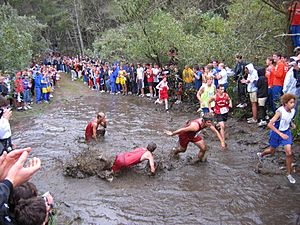Cross-country race facts for kids
Cross country running is an exciting sport where people run races outdoors. They run on natural ground like dirt, grass, or even through forests. Sometimes, cross country runners are called harriers, which is another name for a type of dog.
This sport is both for single runners and for teams. Runners are judged by how fast they finish. Teams get points based on their runners' finishes. The sport is open to everyone, no matter their age or gender. Cross country races usually happen in autumn and winter. This means runners might face rain, snow, or even hail!
Cross country running is part of athletics. It's like a natural version of long-distance races you might see on a track or road. The idea of running races outdoors is very old. However, the rules for modern cross country racing started in Britain. The first national competition was in England in 1876. The first International Cross Country Championships took place in 1903. Today, the biggest race for top runners is the IAAF World Cross Country Championships.
Contents
What is a Cross Country Course Like?
Cross country courses are set up in open fields or wooded areas. The World Athletics organization suggests that courses should be mostly grass. They should also have gentle hills and smooth turns. A course usually has one or more loops. It starts with a long straight path and ends with another straight path to the finish line.
Designing the Course
Every cross country course is different. This is because they use natural land, which can vary a lot! Part of what makes cross country fun is that each race has its own unique terrain and weather. Courses can go through open fields, hilly forests, and sometimes even across small rivers. Runners often have to run up and down hills.
How Long are the Races?
For big international races, each loop of the course is about 1,750 to 2,000 meters long. Runners complete several loops depending on their race.
- Senior men (adults) usually run about 12 kilometers (about 7.5 miles).
- Senior women and junior men (young adults) run about 8 kilometers (about 5 miles).
- Junior women run about 6 kilometers (about 3.7 miles).
How is Scoring Done?
In cross country, scoring is simple. The first runner to finish gets one point. The second runner gets two points, and so on. For team events, the top five runners from each team get points. These points are added up. The team with the lowest total score wins! If there's a tie between teams, the team whose sixth runner finished faster wins.
It's hard to compare times from different races. This is because the course, weather, and other runners can change how fast someone runs. So, two runners with the same time in different places might not be at the same skill level.
What Equipment Do Runners Use?
Cross country running doesn't need a lot of special gear. Most runners wear shorts and a lightweight top, often in their school or club colors. If it's very cold, they might wear long-sleeved shirts and tights to stay warm.
The most common shoes are cross country spikes. These are light racing shoes with a rubber sole. They have five or more metal spikes screwed into the front part of the sole. These spikes help runners grip the ground better, especially on muddy or slippery paths.
Images for kids
-
A children's cross country competition in Croatia
-
Runners at the 2010 European Cross Country Championships in Portugal
-
Individual cross country race at the 1924 Summer Olympics in Paris, France. The left trio is Edvin Wide, Ville Ritola and Paavo Nurmi. Due to the hot weather (over 40 °C (104 °F)) only 15 out of 38 competitors (elite long-distance runners) finished the race.
-
Roy Griak Invitational cross country meet, University of Minnesota
See also
 In Spanish: Campo a través para niños
In Spanish: Campo a través para niños








